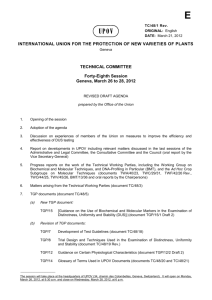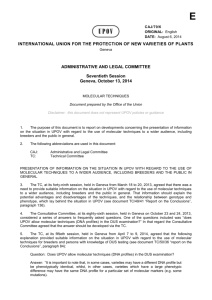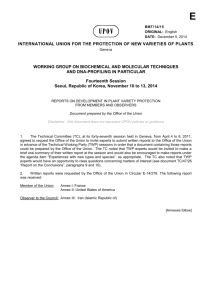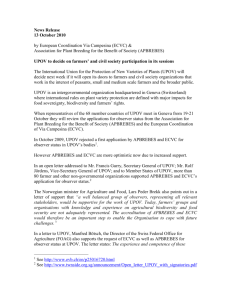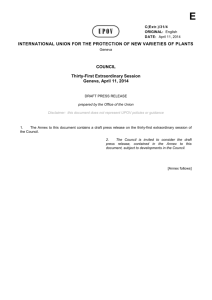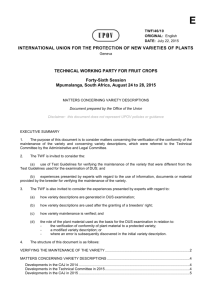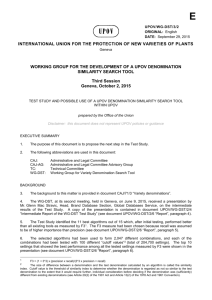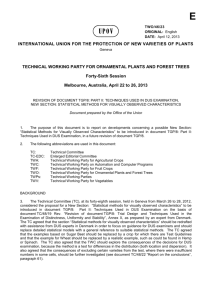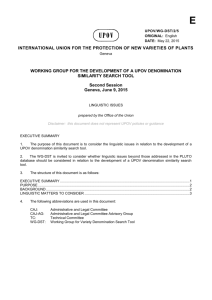Authority`s test guidelines
advertisement
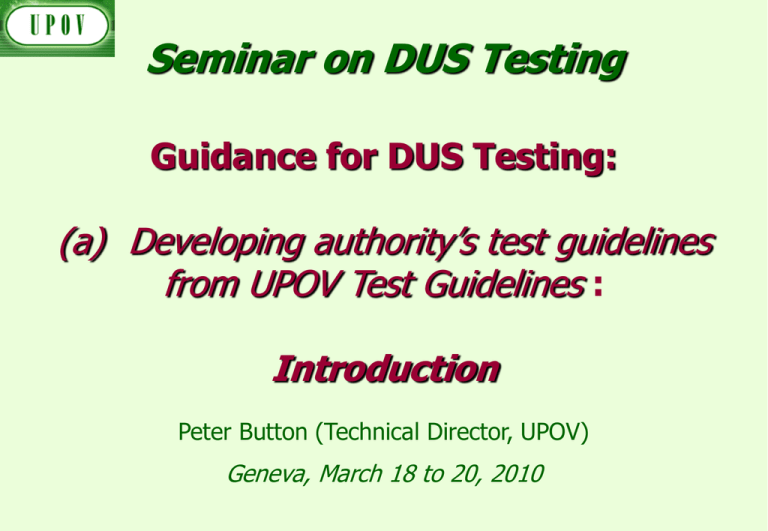
Seminar on DUS Testing Guidance for DUS Testing: (a) Developing authority’s test guidelines from UPOV Test Guidelines : Introduction Peter Button (Technical Director, UPOV) Geneva, March 18 to 20, 2010 Preview • Purpose of UPOV Test Guidelines • Role of TGP/7 “Development of Test Guidelines” – UPOV Test Guidelines – Authority’s test guidelines • Current situation PURPOSE of UPOV TEST GUIDELINES Guidance for DUS Examination facilitates: BEST PRACTICE (based on experience) => good decisions => good definition of the object of protection (strong protection) => efficiency in method of examination (learn from the best) HARMONIZATION => efficiency • mutual acceptance of DUS reports (minimize cost of examination for individual authorities) • mutual recognition of variety descriptions (all parties speak the same “language”) • simple and cheap system for applicants (minimize cost for breeders) UPOV provides guidance by: • The “General Introduction” (TG/1/3) – General technical principles – Organization of DUS Testing – Associated “TGP” Documents (e.g. statistical methods) AND • “Test Guidelines” – Species/Crop-specific recommendations developed by crop experts – TGP/7 “Development of Test Guidelines” adopted UPOV Structure COUNCIL CONSULTATIVE COMMITTEE ADMINISTRATIVE AND LEGAL COMMITTEE TECHNICAL COMMITTEE Technical Working Party on Technical Working Party for Technical Working Party for Technical Working Party for Technical Working Party for Working Group on Biochemical Automation and Computer Programs Agricultural Crops Fruit Crops Ornamental Plants and Forest Trees Vegetables and Molecular Techniques Cooperation between Authorities within UPOV DOCUMENT TGP/5 “EXPERIENCE AND COOPERATION IN DUS TESTING” Section 1: Model Administrative Agreement for International Cooperation in the Testing of Varieties Article 2 Where the Council of UPOV has adopted Guidelines for the Conduct of Tests for Distinctness, Uniformity and Stability (“Test Guidelines”) for a genus or species covered by this Agreement, the examination shall be conducted according to those Test Guidelines. … ROLE of TGP/7 “Development of Test Guidelines” UPOV Test Guidelines 1. Introduction 2. Procedure for the Introduction and Revision of UPOV Test Guidelines 3. Guidance for Drafting Test Guidelines •The TG Template •Additional Standard Wording for the TG Template •Guidance Notes for the TG Template Chapters of UPOV Test Guidelines 1. Subject of the Test Guidelines 2. Material Required 3. Methods of Examination 4. Assessment of Distinctness, Uniformity and Stability 5. Grouping of Varieties and Organization of the Growing Trial 6. Introduction to the Table of Characteristics 7. Table of Characteristics 8. Explanation on the Table of Characteristics 9. Literature 10. Technical Questionnaire Standard Test Guidelines Characteristic Function 1.Characteristics that are accepted by UPOV for examination of DUS and from which members of the Union can select those suitable for their particular circumstances. Criteria 1.Must satisfy the criteria for use of any characteristic for DUS as set out in Chapter 4, section 4.2. 2.Must have been used to develop a variety description by at least one member of the Union. 3.Where there is a long list of such characteristics and, where considered appropriate, there may be an indication of the extent of use of each characteristic. Asterisked Characteristic Asterisked Characteristic Function 1.Characteristics that are important for the international harmonization of variety descriptions. Criteria 1.Must be a characteristic included in the Test Guidelines. 2.Should always be examined for DUS and included in the variety description by all members of the Union EXCEPT when the state of expression of a preceding characteristic or regional environmental conditions render this inappropriate. 3.Must be useful for function 1. 4.Particular care should be taken before selection of disease resistance characteristics. ROLE of TGP/7 “Development of Test Guidelines” Authority’s test guidelines TGP/7/2 Draft 5 (Revision) SECTION 4 (NEW): DEVELOPMENT OF INDIVIDUAL AUTHORITIES’ TEST GUIDELINES 4.1 Individual Authorities’ Test Guidelines based on UPOV Test Guidelines (a) (b) (c) (d) (e) (f) (g) Quantity of plant material to be supplied by the applicant Selection of characteristics from the Test Guidelines Example varieties Additional characteristics Modification of Test Guidelines characteristics Revision of Test Guidelines Technical Questionnaire characteristics 4.2 Individual Authorities’ Test Guidelines in the absence of UPOV Test Guidelines 4.3 Drafter’s Kit for Test Guidelines Current situation Test Guidelines • 257 Test Guidelines adopted but… • >2,750 genera and species with varieties examined for PBR PRIORITY for UPOV Test Guidelines PRIORITY for species or crops with high: - number of authorities receiving PBR applications; - number of PBR applications; - number of foreign applications received by UPOV members; - economic importance; - level of breeding activity Seminar on DUS Testing Guidance for DUS Testing: (b) DUS testing in the absence of UPOV Test Guidelines …later THANK YOU
